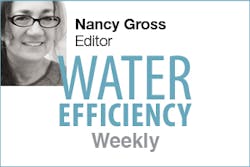I am a child of the ’70s, and the TV personalities of those years surely live in the webbing of my brain. And don’t these pop culture reference points interlace with all the other learning we accumulate throughout our days? While considering good-tasting tap water, Charlie Tuna swam right out of this net. Were you around for those StarKist commercials where the distinction was made between “tuna with good taste” and “tuna that tastes good?” Silly as it was, it made its point, putting the focus on flavor.
Every year at the American Water Works Association’s (AWWA) Annual Conference and Exposition (ACE), there is a Best of the Best Tap Water Taste Test that takes place. Big Sky County Water and Sewer District of Big Sky Montana took this year’s prize, with Universal City, Texas, taking second place. There was a tie for third place between Albuquerque Bernalillo County Water Utility Authority and the Boston Water and Sewer Commission.
I was at ACE last week and attended a session put on by repair company, HomeServe, titled “Innovative Communication and Engagement Strategies for Improving Customer Relationships.” One of the presenters was from a 2008 and 2013 AWWA Best Tap Water Taste winner, Louisville Water, in Kentucky. The speaker, Vince Guenther, shared about how his water utility trademarked their water with the name pure tap®. Over the years, their branding has changed because the original strategy of labeled plastic bottles put too much focus on the bottles, which were not meant to be single use containers, but tended to be used that way. I guess they had to infiltrate the territory occupied by bottled water to make a case for their clean and great tasting city water, but as the problem of plastic trash mounts, they are shifting their messaging. Now they provide branded fountains at some key locations like the Louisville Zoo, and supply water coolers and cups at sporting and cultural events. I imagine this helps customers take the water utility more seriously, and with pride in the local water, the need to maintain the infrastructure can’t be too hard of a sell.
Getting back to Charlie Tuna and good taste versus tasting good, water customers do turn up their noses at some things that don’t seem tasteful, even when water tastes good and is safely drinkable. While at ACE I also toured the Mesa Water Reliability Facility (MWRF) and learned a little about geology, hydrology, and filtration.
Some deep water wells tapped by the city of Costa Mesa, CA, bring up water with an amber tint to it. The water’s color comes from an ancient Redwood forest, pushed underground by natural forces. Their presence is an indication that the now arid region just south of Los Angeles was once wet like the northern California coast. The water meets all water-quality standards, and it is said that some restaurants 100 years ago obscured the water’s color by serving it in amber-colored glasses. It was also considered a health tonic by some in bygone days, and I would imagine that “Redwood Water” would appeal to a niche market today. But for general purposes, water customers are put off by the color, so the Mesa Water Reliability Facility “gets the red out” (couldn’t resist another TV commercial reference) using a nanofiltration process. Water and salts pass through; the organic color molecules are the only thing the filters need to reject at this fully automated facility. The community enjoys an entirely local water supply, which is rare in southern California, and rates are set based on true costs with none of the confusion that can come when some utility funding comes through taxes. By sourcing this section of the deep aquifer, Costa Mesa helps to keep the reddish organic material from spreading into the intake areas of other local water districts. It seems they are hitting the marks for “good taste” along with water that “tastes good!”
FYI—I think you may want to know about some of the master classes and webinars available this week from our online professional education division, Forester University. Please visit the Forester University link to learn about all upcoming offerings.
And a Design & Construction of Permeable Pavements Webinar goes into the details of what you need to consider for the design and construction of your permeable pavements to ensure that they produce the best water quality and collect the most runoff possible.
